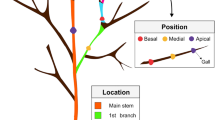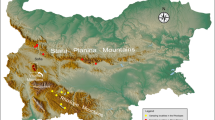Summary
Yearly population fluctuations ofM. pustulae were investigated at 19 sites in Kyushu. In sites where a platygastrid is the only parasitoid of the midge, the percentage parasitism was very low in the incipient stage of the outbreak of the midge populations. After the number of midges reached a peak, the midge populations declined as the percentage parasitism increased, and then the outbreak ceased. On the other hand, in several populations no outbreak was found and the percentage parasitism was constantly at a high level. Therefore, the immediate cause for the outbreak seemed to be a decline of the percentage parasitism. Like the midge, the platygastrid has one generation each year, and its females also emerge in spring to deposit their eggs within host eggs. The decline of the percentage parasitism seemed to be mainly affected by the time lag between emergence periods ofM. pustulae and the platygastrid.
In the midge populations parasitized by both the platygastrid and a eulophid (Chrysonotomyia sp.), an extinction of the population was observed, resulting from parasitism by the latter,Chrysonotomyia sp. is polyphagous and multivoltine, and is a late parasitoid, as discussed byAskew (1975). When the density of the midges is very low, the platygastrid may leave the host eggs unparasitized, whileChrysonotomyia sp. may not, because the mature galls are conspicuous.
Similar content being viewed by others
References
Askew, R. R. (1975) The organization of chalcid-dominated parasitoid communities centred upon endophytic hosts. 130–153. InP. W. Price (ed)Evolutionary strategies of parasitic insects and mites. Plenum Press, New York and London.
Barnes, H. F. (1935a) Studies of fluctuations in insect populations. IV. The arabis midge,Dasyneura arabis (Cecidomyidae).J. Anim. Ecol. 4: 119–126.
Barnes, H. F. (1935b) Studies of fluctuations in insect populations. V. The leaf-curling pear midge,Dasyneura pyri (Cecidomyidae).J. Anim. Ecol. 4: 244–253.
Clausen, C. P. (1940)Entomophagous insects. McGraw-Hill, New York and London.
Force, D. C. (1975) Succession ofr andK strategists in parasitoids. 112–129. InP. W. Price (ed)Evolutionary strategies of parasitic insects and mites. Plenum Press, New York and London.
Maeda, N., S. Satô andJ. Yukawa (1982) Polymodal emergence pattern of the machilus leaf gall midge,Daphnephila machilicola Yukawa (Diptera, Cecidomyiidae).Kontyû 50: 44–50.
Miyashita, K., Y. Itô, K. Nakamura, M. Nakamura andM. Kondo (1965) Population dynamics of the chestnut gall-wasp,Dryocosmus kuriphilus Yasumatsu (Hymenoptera; Cynipidae). III. Five year observation on population fluctuations.Jap. J. Appl. Ent. Zool. 9: 42–52.
Pianka, E. R. (1970) Onr- andK-selection.Amer. Natur. 104: 592–597.
Price, P. W. (1973) Parasitoid strategies and community organization.Environ. Entomol. 2: 623–626.
Redfern, M. andR. A. D. Cameron (1978) Population dynamics of the yew gall midgeTaxomyia taxi (Inchbald) (Diptera: Cecidomyiidae).Ecol. Entomol. 3: 251–263.
Southwood, T. R. E., R. M. May, M. P. Hasell andG. R. Conway (1974) Ecological strategies and population parameters.Amer. Natur. 108: 751–804.
Sunose, T. (1983) Studies on the population dynamics of the euonymus gall midgeMasakimyia pustulae Yukawa etSunose (Diptera, Cecidomyiidae) under different environmental conditions.Kontyû 51: 29–40.
Sunose, T. (1984) Parasitoid complex of the euonymus gall midgeMasakimyia pustulae Yukawa etSunose (Diptera: Cecidomyiidae) in Japan.Kontyû 52: 557–564.
Varley, G. C. (1947) The natural control of population balance in the Knapweed gall-fly (Urophora jaceana).J. Anim. Ecol. 16: 139–187.
Yukawa, J. (1983) Arthropod community centred upon the neolitsea leaf gall midge,Pseudasphondylia neolitseae Yukawa (Diptera, Cecidomyiidae) and its host plant,Neolitsea sericea (Blume) Koidz. (Lauraceae).Mem. Fac. Agr. Kagoshima Univ. 19: 89–96.
Yukawa, J. andT. Sunose (1976) Description of a new gall midge (Diptera, Cecidomyiidae) onEuonymus, with notes on its bionomics.Kontyû 44: 159–168.
Author information
Authors and Affiliations
Rights and permissions
About this article
Cite this article
Sunose, T. Population regulation of the euonymus gall midgeMasakimyia pustulae Yukawa andSunose (Diptera: Cecidomyiidae) by hymenopterous parasitoids. Res Popul Ecol 27, 287–300 (1985). https://doi.org/10.1007/BF02515467
Issue Date:
DOI: https://doi.org/10.1007/BF02515467




